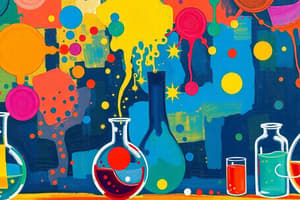Podcast
Questions and Answers
Which characteristic primarily distinguishes matter in the plasma state from matter in the gaseous state?
Which characteristic primarily distinguishes matter in the plasma state from matter in the gaseous state?
- Uniform molecular structure
- Definite shape and volume
- Ability to conduct electricity (correct)
- Inability to be compressed
If a researcher is studying the rate at which a reaction occurs by varying temperature and concentration, which branch of chemistry is this research MOST aligned with?
If a researcher is studying the rate at which a reaction occurs by varying temperature and concentration, which branch of chemistry is this research MOST aligned with?
- Biochemistry
- Organic chemistry
- Analytical chemistry
- Physical chemistry (correct)
When a strong acid is mixed with a strong base, which of the following BEST describes the resulting solution at the equivalence point?
When a strong acid is mixed with a strong base, which of the following BEST describes the resulting solution at the equivalence point?
- It will contain only water and the conjugate acid.
- It will contain a salt and water but may not have a pH of 7 depending on the specific acid and base. (correct)
- It will resist changes in pH upon addition of more acid.
- It will always have a pH of 7.
In a chemical reaction, if the actual yield of a product is less than the theoretical yield, which of the following factors could be a valid explanation?
In a chemical reaction, if the actual yield of a product is less than the theoretical yield, which of the following factors could be a valid explanation?
Which of the following correctly describes the roles of reactants and products in a chemical equation?
Which of the following correctly describes the roles of reactants and products in a chemical equation?
How does a catalyst increase the rate of a chemical reaction?
How does a catalyst increase the rate of a chemical reaction?
A substance is found to have a non-uniform composition and can be separated by physical means. What type of matter is it?
A substance is found to have a non-uniform composition and can be separated by physical means. What type of matter is it?
Which of the following describes the number of atoms in one mole of a substance?
Which of the following describes the number of atoms in one mole of a substance?
Which of the following properties distinguishes an element from a compound?
Which of the following properties distinguishes an element from a compound?
What type of bonding is primarily responsible for the formation of molecular compounds?
What type of bonding is primarily responsible for the formation of molecular compounds?
Why is chemistry often referred to as the 'central science'?
Why is chemistry often referred to as the 'central science'?
Which branch of chemistry is MOST involved in studying the chemical processes within living organisms?
Which branch of chemistry is MOST involved in studying the chemical processes within living organisms?
What is the defining characteristic of a homogeneous mixture?
What is the defining characteristic of a homogeneous mixture?
What is the role of protons, neutrons, and electrons in an atom?
What is the role of protons, neutrons, and electrons in an atom?
In a chemical reaction, what is meant by the term 'limiting reactant'?
In a chemical reaction, what is meant by the term 'limiting reactant'?
Which of the following describes the purpose of stoichiometry in chemistry?
Which of the following describes the purpose of stoichiometry in chemistry?
What is the primary function of a buffer solution?
What is the primary function of a buffer solution?
How do exothermic reactions differ from endothermic reactions?
How do exothermic reactions differ from endothermic reactions?
How is pH used to classify a substance as acidic, basic, or neutral?
How is pH used to classify a substance as acidic, basic, or neutral?
Which of the following is a characteristic of inorganic compounds?
Which of the following is a characteristic of inorganic compounds?
Flashcards
Chemistry
Chemistry
The study of matter and its properties, including how matter changes.
Analytical Chemistry
Analytical Chemistry
Studies the chemical components of natural and artificial materials.
Biochemistry
Biochemistry
Examines chemical processes within living organisms.
Inorganic Chemistry
Inorganic Chemistry
Signup and view all the flashcards
Organic Chemistry
Organic Chemistry
Signup and view all the flashcards
Physical Chemistry
Physical Chemistry
Signup and view all the flashcards
Matter
Matter
Signup and view all the flashcards
Element
Element
Signup and view all the flashcards
Atoms
Atoms
Signup and view all the flashcards
Compound
Compound
Signup and view all the flashcards
Mixture
Mixture
Signup and view all the flashcards
Homogeneous Mixture
Homogeneous Mixture
Signup and view all the flashcards
Heterogeneous Mixture
Heterogeneous Mixture
Signup and view all the flashcards
Chemical Reaction
Chemical Reaction
Signup and view all the flashcards
Exothermic Reactions
Exothermic Reactions
Signup and view all the flashcards
Endothermic Reactions
Endothermic Reactions
Signup and view all the flashcards
Mole
Mole
Signup and view all the flashcards
Acids
Acids
Signup and view all the flashcards
Bases
Bases
Signup and view all the flashcards
pH
pH
Signup and view all the flashcards
Study Notes
- Chemistry is the study of matter and its properties as well as how matter changes
- It is a natural science that studies the composition, structure, properties, and reactions of matter
- Chemistry concerns the study of atoms and their interactions with other atoms
- Chemistry concerns the formation of new substances through chemical reactions
- Chemistry is sometimes called the "central science" because it connects other natural sciences like physics, geology, and biology
- Chemistry is applied across a wide variety of fields, including medicine, agriculture, and manufacturing
Branches of Chemistry
- Analytical chemistry studies the chemical components of natural and artificial materials
- Biochemistry studies chemical processes in living organisms
- Inorganic chemistry studies the properties and reactions of inorganic compounds
- Organic chemistry studies the structure, properties, and reactions of organic compounds, which contain carbon
- Physical chemistry applies physics to the study of chemical systems
Matter
- Matter is anything that has mass and takes up space (volume)
- Matter exists in different states, including solid, liquid, gas, and plasma
- Solids have a definite shape and volume
- Liquids have a definite volume but take the shape of their container
- Gases have no definite shape or volume and can be compressed or expanded
- Plasma is a state of matter where a gas becomes ionized and carries an electrical charge
- Matter can be classified into two main categories: pure substances and mixtures
- Pure substances have a fixed composition and distinct properties, and are either elements or compounds
- Mixtures are combinations of two or more substances that are physically combined
Elements
- An element is a pure substance that cannot be broken down into simpler substances by chemical means, and is composed of only one type of atom
- Atoms are the basic building blocks of matter and consist of protons, neutrons, and electrons
- Protons have a positive charge, neutrons have no charge, and electrons have a negative charge
- The number of protons in an atom determines the element's atomic number
- Elements are organized in the periodic table based on their atomic number and chemical properties
- Elements in the same group (vertical column) of the periodic table have similar chemical properties
- Metals, nonmetals, and metalloids are the three main types of elements
Compounds
- A compound is a pure substance consisting of two or more different elements chemically bonded together in a fixed ratio
- Compounds can be broken down into simpler substances by chemical means
- Chemical formulas represent compounds, using symbols to indicate the elements and subscripts to indicate the number of atoms of each element
- Molecular compounds are formed through covalent bonds, where atoms share electrons
- Ionic compounds are formed through ionic bonds, where electrons are transferred between atoms, creating ions
Mixtures
- A mixture is a combination of two or more substances that are physically combined, and can be either homogeneous or heterogeneous
- Homogeneous mixtures have a uniform composition throughout
- Heterogeneous mixtures have a non-uniform composition throughout
- Mixtures can be separated by physical means, such as filtration, distillation, or evaporation
Chemical Reactions
- A chemical reaction is a process that involves the rearrangement of atoms and molecules to form new substances
- Chemical equations represent chemical reactions, using symbols and formulas to show the reactants (starting materials) and products (substances formed)
- Chemical reactions involve the breaking and forming of chemical bonds
- Energy is either absorbed or released during a chemical reaction
- Exothermic reactions release energy, while endothermic reactions absorb energy
- Activation energy is the minimum energy required for a chemical reaction to occur
- Catalysts speed up chemical reactions by lowering the activation energy
Chemical Quantities
- The mole is the SI unit for measuring the amount of a substance
- Avogadro's number (6.022 x 10^23) is the number of entities (atoms, molecules, ions, etc.) in one mole of a substance
- Molar mass is the mass of one mole of a substance, usually expressed in grams per mole (g/mol)
- Stoichiometry is the study of the quantitative relationships between reactants and products in chemical reactions
- Stoichiometry allows us to predict the amount of reactants and products involved in a chemical reaction
- Limiting reactant is the reactant that is completely consumed in a chemical reaction, determining the maximum amount of product that can be formed
- Percent yield is the ratio of the actual yield (amount of product obtained) to the theoretical yield (amount of product predicted by stoichiometry), expressed as a percentage
Acids and Bases
- Acids are substances that donate protons (H+) in aqueous solutions
- Bases are substances that accept protons (H+) in aqueous solutions
- pH is a measure of the acidity or basicity of a solution
- pH values range from 0 to 14, where 0-7 is acidic, 7 is neutral, and 7-14 is basic
- Strong acids and bases completely dissociate in water, while weak acids and bases only partially dissociate
- Acid-base reactions involve the transfer of protons from an acid to a base
- Neutralization is the reaction between an acid and a base, which produces a salt and water
- Buffers are solutions that resist changes in pH upon the addition of small amounts of acid or base
Studying That Suits You
Use AI to generate personalized quizzes and flashcards to suit your learning preferences.




